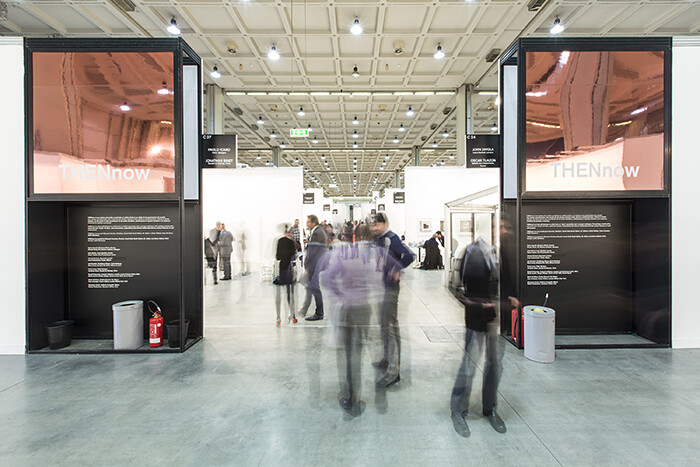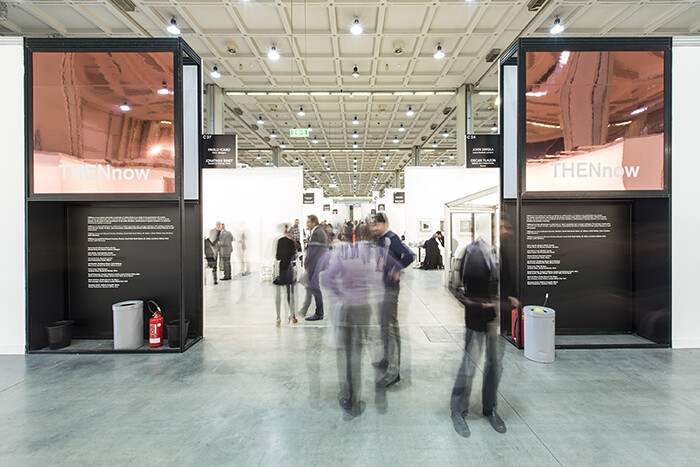Milan, a city that cultivates its world-famous reputation as the capital of fashion and design, is currently taking big steps to relaunch its identity as a center for artistic production, and miart, its two-year-old upstart art fair, has been playing an essential role in this reinvention. With its access-controlled, rational grid plan, the fair’s architecture gives the impression of visiting a city within a city; its perfectly linear alleyways intersecting other equally perfect linear alleyways, its circulation system and signs, its various accommodation settings and meeting points, and its diverse sectors allow one to reflect on miart’s own relationship to the revamping of Milan’s cultural politics. The fair’s unavoidable sprawl is replete with a gentrified center where the old meets the new, and traditional, conservative enclaves meet newly developed areas.
The fact that miart is on a vastly smaller scale than the city of Milan itself—one that can be traversed and observed in a couple of hours—makes it an optimal site for testing out a paradigm of vision Irish writer and artist Brian O’Doherty conceived in close connection to contemporary art.1 O’Doherty’s “vernacular glance” refers to the fast mode of attention by which we process the city’s overwhelming multitude of visual information in an almost unconscious way. As he argues, while traversing an urban space, the mind flattens out the viewing experience, leading to a generalized loss of interest in particulars: the greater the number of places and situations encountered, the more of their peculiarities are lost and become identical to one another. What follows is an account of the exceptions to the rule—those rare moments at miart that defy O’Doherty’s characterization. It consists of brief descriptions of exceptional encounters that inhibited the tendency to arrange surplus information into safe categories.
The pairing of American Cory Arcangel and late Italian artist Mario Schifano (1934–1998) in the THENnow section definitely introduced a rupture in this fair-goer’s vernacular glance. One of the few coherently-conceived spaces at miart—something largely achieved by the Persian blue carpet that covered the entire floor—the presentation superbly explores the two artists’ shared interest in technology, mass media, pop culture, and their material and visual supports. Even if the works were created at a remove of almost fifty years, Schifano’s Paesaggio anemico [Anemic Landscape] and New Groovy Courreges for Betty (both 1965) and Arcangel’s chromogenic prints and looped videos—Max Perks (officemax.com), Ideas In Action (starbucks.com), and So shines a good deed in a weary world (dunkindonuts.com) (all 2014)—create fascinating, timeless dialogues with one another. Elsewhere at the fair, Schifano’s “De Sex” series from the 1980s—photographic manipulations of television screens showing porn movies presented at the booth of Milan’s Studio Giangaleazzo Visconti—offers a curious expansion of the artist’s exploration on the visual imaginary generated by television. Also at THENnow, and equally remarkable—even if in more sober tones—is the coupling of the work of Norwegian artist and writer Matias Faldbakken and late Italian artist Giuseppe Uncini (1929–2008). If the dark and dirty images of Faldbakken’s Book Scans (2010) seem to take up the baton of Uncini’s pioneering crudity and roughness, the latter’s Brutalist concrete sculptures—whose untreated, rough surfaces bear the traces of their industrial processes—add an important physicality to Faldbakken’s two-dimensional scans.
The vernacular glance is elsewhere subverted by another crossing of plasticity and technology, this time by way of French artist Neïl Beloufa’s excellent display at Milan’s own Galleria ZERO…. His “Vintage” series (2012–14) consists of large, carved boards of compressed wood framed by a metal structure and equipped with various electrical supplies: sockets, switches, and cables. The final result is a curious parietal presence, situated somewhere between frieze, design object, and utilitarian device. Two fragments of Beloufa’s Superlatives and Resolution (2013)—the stunning installation the artist presented at the 12th Biennale de Lyon last year—are also visible, but this time without the videos, which were such an important element of the whole. The disturbed, fragmented vision of the original series—here deprived of their moving image components—has been lost. The visitor is left to imagine how these support structures might acquire life once immersed in sound, light, and movement.
Considering that the vernacular glance was a concept O’Doherty first elaborated in relation to the work of Robert Rauschenberg—an artist for whom collage was a key element—it may not be coincidental that this medium prevails throughout miart. All sorts of collages spanning sections, periods, and approaches are to be seen here. Not only are disparate artistic practices brought together in a collage-style—as seen in the pairings in the fair’s THENnow section (by far the event’s most successful sector)—but collage as an artistic technique seems to have become increasingly prevalent in recent years. We see it in Cadoro (Vittorio Veneto 05/12/13) and Emisfero (Vittorio Veneto 20/12/13) (both 2014), Madrid-based Nico Vascellari’s large childish and colorful magazine cuttings at Rome’s Monitor; in New Reproductions (2013), Croatian artist David Maljkovic’s photographs mounted on board at Brescia’s Galleria Massimo Minini; or even, in Image Persistence (Grey Text Painting 46) (2013), Philomene Pirecki’s beautiful wall installation at London’s Supplement gallery (one of the very few remarkable elements of the Emergent section, whose promise of the new is otherwise disappointingly old). Collage has an intimate relationship with the past, mostly because it often relies on the reuse of found, extant materials. Not surprisingly, it also appears in the work of some historical figures, like Italian artist Michelangelo Pistoletto, whose Mirrors (1962–2007), assemblages of images on reflexive surfaces, evince a clear aggregative spirit. At Milan’s Galleria Repetto, the Caged Monkey (1962–73), one of his serigraphs on mirror, is particularly remarkable.
Collage is also a useful metaphor to describe the outstanding, multidirectional effort of miart’s recent artistic direction. It has endeavored to establish strong bonds between Milan’s past and future by creating alliances with some of the city’s key cultural initiatives—namely with Mousse magazine, which has been responsible for the fair’s visual communication and design—and connecting the city’s focus on fashion and material culture with the visual arts. Miart also strives to mediate between establishing a relevant national presence while simultaneously maintaining its international appeal. Above all, in attempting to reinvent an artistic local scene almost from scratch, the fair has done much to improve its host city within two short years. Eventually such labor will bear even more fruit, but in the meantime, the urgent reinvention of Milan’s cultural life is surely being well-served by miart’s team and partners.
Brian O’Doherty, “Rauschenberg and the Vernacular Glance,” Art in America, vol. 61 (September 1973): 84.









